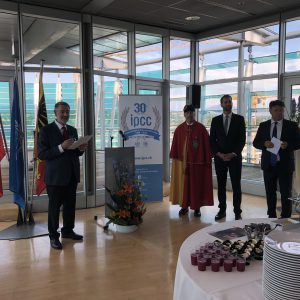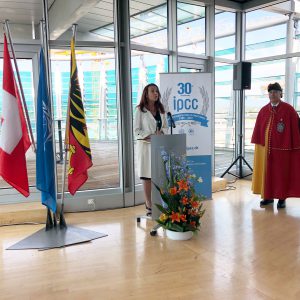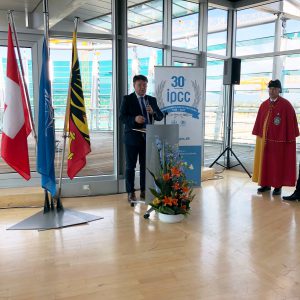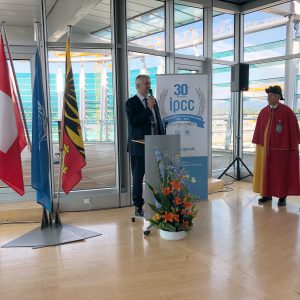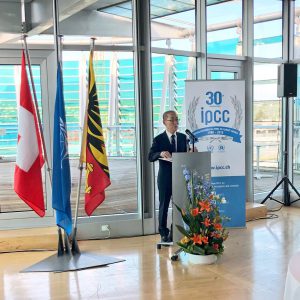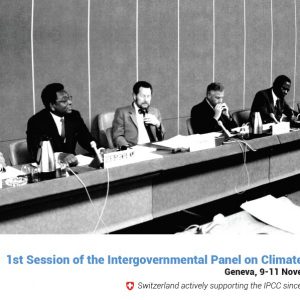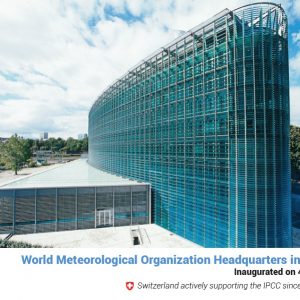Event
IPCC 30th Anniversary Event hosted by Switzerland
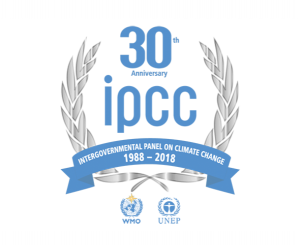
28 Jun 2018
18:00–18:00
Venue: Restaurant L’Attique | World Meteorological Organization
Organization: Geneva Environment Network
The Intergovernmental Panel on Climate Change (IPCC) was established by the World Meteorological Organization and the United Nations Environment Programme in 1988 to provide the world with a clear scientific view on the current state of knowledge in climate change and its potential environmental and socio-economic impacts.
The IPCC activity is funded through voluntary contributions, and thousands of scientists and other experts contribute on a voluntary basis as authors, contributors and reviewers.
On the occasion of the celebration of the IPCC 30th anniversary, the Swiss Federal Council, the State Council of the Republic and Canton of Geneva and the Executive Council of the City of Geneva organized a reception on Thursday 28 June 2018.
Statements
- José Romero, Swiss Federal Office for Environment (Moderator)
- Antonio Hodgers, Geneva State Council Vice-President
- H.E. Valentin Zellweger, Switzerland Permanent Representative to the United Nations Office in Geneva
- Petteri Taalas, WMO Secretary-General
- Jan Dusik, UN Environment Europe Office Director a.i.
- Ovais Sarmad, UNFCCC Deputy Executive Secretary
- Hoesung Lee, IPCC Chair
Remarks by IPCC Chair, Hoesung Lee
On the occasion of the 30th Anniversary Commemoration for the IPCC hosted by Swiss Confederation, Canton of Geneva and City of Geneva
One hundred years ago Albert Einstein gave an address to the Physical Society of Berlin, in which he reflected on what inspires people to become scientists.
These include the joyful exercise of the intellect, devoting science to utilitarian purposes, and an escape from everyday life into a realm of objective perception and thought.
“In the temple of science are many mansions, and various indeed are they that dwell therein and the motives that have led them thither,” he said.
Einstein had found a home in Switzerland, and taken Swiss citizenship.
While employed at the federal patent office in Bern he published some of his greatest works, including the four papers of his annus mirabilis in 1905.
The IPCC too has found a home in Switzerland.
Our Secretariat is housed here at the WMO headquarters in Geneva, where many of our plenary and bureau sessions and expert meetings take place. We gratefully recognize the support of the WMO and UN Environment, our parent organizations.
We are very grateful to the Swiss authorities for their generous support to the IPCC – practical, financial and scientific.
I would like to use this 30th anniversary celebration, kindly hosted by the Swiss Confederation, Canton of Geneva and City of Geneva, to discuss some ideas around the science of climate change that are relevant to the Sixth Assessment Report.
These are personal reflections and not intended to prejudge the outcome of the report.
Firstly, let me note the cross-disciplinary and cross-cutting nature of this new report which means more experts from the social sciences are joining our author team.
I am also pleased to note that we have improved both geographical and gender balance among our authors.
30 years of IPCC assessments have concluded that anthropogenic climate change is real, its threats will increase and may become irreversible, and we have the means to stop it.
Cost-effective climate stabilization would require us to take immediate action to reduce global emissions of greenhouse gases.
Technologies to reduce emissions on the scale needed are available and are likely to become more cost-effective throughout this century.
At the same time we have found that, in most countries, governments are addressing climate change in the context of other national priorities, such as energy security and poverty alleviation, and that many actors are involved in this effort, including city governments and business sectors.
The implications for future climate action are clear.
To be successful and effective, future climate action must be relevant to broad national priorities and societal concerns.
Therefore science should provide insights into the nature of the link between climate action and other national priorities, and characterize the interaction and feedback between these two aspects.
Understanding this link requires improved scientific information on, among other things, the damage due to climate change and on how climate action may interact with the sustainable development goals, or SDGs.
Our understanding of the damage caused by climate change remains limited by large uncertainties at the global and regional scale.
We need to improve our understanding of bio-geophysical processes at various spatial and temporal scales, including biological productivity, changes in water availability, and the adaptive capacity of natural and human systems.
We also need to close knowledge gaps around thresholds for the tipping points that would lead to irreversible changes in climate and socioeconomic systems.
And we need to enhance our scientific understanding of gradual changes and low-probability, high-consequence impacts.
Then there is the challenge of going beyond a simple assessment running from emissions, to climate change, to impacts.
This approach lacks a holistic understanding of economic development, emissions, climate change and damage projections.
Integrated assessment modelling, or IAM, should be able to close the loop through a feedback of estimates of climate damage on the socioeconomic system.
However, that feedback is largely missing from the current IAM analysis.
Incorporating these climate feedbacks into socioeconomic system projections would provide information on the relative weight of threats from climate change and threats to other national priorities.
Climate policies that also address threats to other national priorities are more likely to be implemented and to be cost-effective.
This leads me to the second area where additional scientific input is needed, namely an improved understanding of interactions with the SDGs.
The SDG targets for water, energy, land use, sustainable consumption and production, education, infrastructure and industrialization have a direct influence on the level and rate of baseline emissions for the future.
And the SDG targets, individually and collectively, will affect the productivity of physical, human, and natural capital, and thus the state of the future economy.
A scientific understanding of these interactions with the SDGs will provide insights into how climate change solutions can help address other threats and priorities.
This also has implications for the work of the IPCC.
Improving our understanding of climate damage and its interaction with the SDGs will require collaboration between the natural and social sciences, especially contributions from the social sciences in the current 6th assessment.
This is because implementing the Paris Agreement is not just about technology.
It involves understanding social values, consumption and behaviour.
Besides insights from the natural sciences we need to look at the human side of the transition toward a low-carbon future – economics, social sciences, psychology, politics, international relations.
We must calculate the risks associated with different emissions pathways, but we also need to understand how different stakeholders judge and respond to risk.
Again, this goes beyond technology and scientific calculation to an understanding of values and motivation.
We must improve our understanding of decision-making by countries, cities and businesses, and individual consumers and citizens.
What will differentiate the Sixth Assessment Report from previous assessments is that it will present a scientifically robust clear link between climate action and economic development.
We have moved on from proving human intervention in the climate system to demonstrating the necessity of climate policy being the main driver of economic policy for the 21st century.
The new assessment also provides an opportunity to develop our understanding of the economics of climate action.
The commonplace view is that taking action is costly, even though the Fifth Assessment Report showed that cost-effective mitigation amounted to only a very small delay in growth over time rather than significant losses.
The cost of mitigation is often calculated as the difference between a mitigation pathway or reduced or falling emissions, and baseline emissions projected to grow at 3% a year over the century.
But the higher the projected baseline emissions, the bigger the gap with the mitigation pathway and the higher the mitigation cost appears to be.
With the mitigation pathway given by the climate goal, the IAM-calculated mitigation cost depends up on the level of baseline emission that the model assumes.
This mitigation cost can be challenged in a number of ways.
For example, if carbon-intensive energy consumption continues unabated, the impacts of climate change on the economy will reduce economic growth, in turn resulting in lower energy demand, and thus a lower baseline.
To put it another way, business as usual may be very far from usual in a high carbon world.
When we set the costs of doing nothing against the new economy opportunities arising from climate action, the equation becomes very different.
30 years ago when the IPCC’s First Assessment Report was launched, Professor Bert Bolin, the first Chair of the IPCC, made it clear that the report should include proposals for action.
While a fine balance would have to be struck between the available scientific evidence for climate change and the uncertainties in that knowledge base, he emphasized that there should be no delay in preparing to act to safeguard the future of the planet.
His insight and advice have survived the test of time, and the spirit of science for climate action will prevail.
Thank you for your attention.

